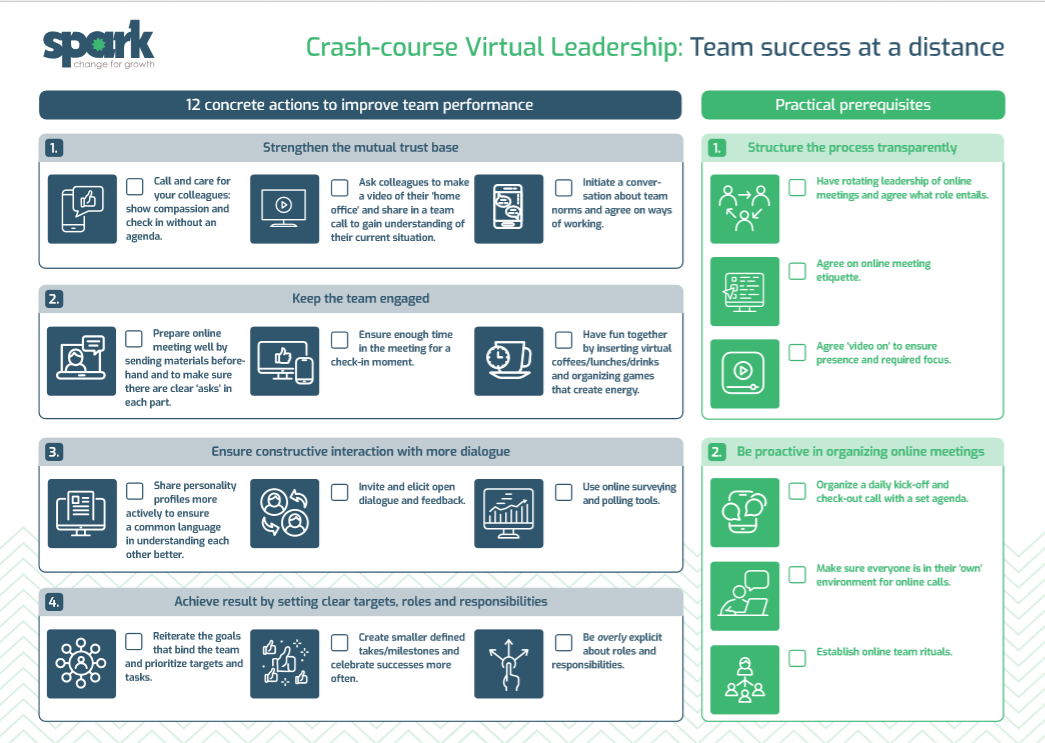'Crash-Course' Virtual Leadership: Team Success at a Distance
Since Covid19 has disrupted the world, the reality of working from home presents a new challenge for most leaders: how to ensure team success when working virtually? While on the one hand working remotely is turning out to strengthen bonds, on the other hand it presents teams and their leaders challenges in working together effectively and keeping engaged. At the same time those same leaders and managers, as well as their team members are increasingly feeling the stress of this new reality. The challenge to perform professionally with the added responsibility (for some of us) to home school our children, alongside being cooped up at home and not being able to have the kind of ‘warm’ social interaction that we humans crave. This crisis can impact our mental health, with alarming reports showing that three-out-of-four are feeling anxious and depressed.
Leaders need to ask themselves how they will manage to achieve their targets, but more importantly, how to maintain their trust base and keep their teams engaged. Whilst the virtual way of working is something most of us are quickly becoming experienced in, we also know that those who already were accustomed to working in virtual teams will say that face-to-face touchpoints are the moments when milestones are defined and mutual trust and engagement are strengthened.
As it will take months before we return to any kind of 'normal', we need a practical crash course on virtual leadership: “Team Success at a Distance”. And we need to find hope in research pieces that report virtual teams deliver higher performance when managed successfully.
Team success relies on the following four layers, ranked according to relevance. ‘Result’ is ranked as number four, and therefore should tell you that you cannot achieve results successfully if the first three layers are ignored. So for any leader reading this document, make sure to get underway with actions on the first layers before skipping to what might feel most urgent. A focus on mutual trust, engagement and constructively dealing with conflict will help you through this crisis.

12 concrete actions to improve team performance described in more detail:
1. Strengthen the mutual trust base
- Call and care for your colleagues: show compassion and check in without an agenda. Proactive contact about how things are at home will strengthen the notion of feeling connected and will inspire trust that they are being heard, also in personal struggles. Randomly checking in is more important than ever before, because there is no picking up on signals that things are not going well when working virtually.
- Ask colleagues to make a video of their ‘home office’ and share it in a team call to gain understanding of their current situation. By allowing a look into each other’s home setting, understanding that one might be much more challenged by their personal situation than another, will improve the team dynamic. There is a stark difference in what can currently be expected from the colleague who has a nice quiet home office with no distractions compared with the colleague working from the kitchen table with a one and three-year old asking for constant attention.
- Initiate a conversation about team norms and agree on ways of working. Don’t assume you can copy-paste old norms into this new situation. This different way of working requires a conversation about expectations, about working hours and ways of interacting. Be conscious that the ‘offline chats’ amongst a few in the office will be replaced by calls or whatsapp groups. Those can damage team dynamics and therefore need discussing openly to uncover, and to understand what the underlying factors are.
2. Keep the team engaged
- Prepare online meetings well by sending materials beforehand and by making sure there are clear ‘asks’ in each part. If everyone has seen what will be discussed and has been able to do thinking on which ‘ask’ or question needs resolving, it will be easier to have full engagement in the call. To give it even more body, you may consider sending around a video message as a WhatsApp beforehand alluding to the agenda and how you would like everyone to be engaged.
- Ensure enough time in the meeting for a check-in moment. Before diving into the content of the meeting, do a check-in to hear how everyone is doing. Depending on the group size and the needs in the team, this may take a little longer or you may reduce it to asking at the start ‘Describe in one word how you’re doing’. This will help you understand who needs more personal attention. Likewise, you can finish off meetings with a check-out and perhaps ask everyone to indicate with thumbs up to down how well engaged they felt the call was.
- Have fun together by inserting virtual coffees/lunches/drinks and organizing games that create energy. Freeing up time for relaxed contact is very needed in these times, and without opportunities to have a coffee together much of the free-spirited chat gets lost. Social contact and shared fun are essential to ensure engagement, so build it in. For inspiration on fun games find increasing inspiration on the web (e.g. check out Museum Hack)
3. Ensure constructive interaction with more dialogue
- Share personality profiles more actively to ensure a common language in understanding each other better. Be it MBTI, Management Drives, Disc or any other kind of instrument, start using the language they provide proactively to allow for non-judgmental interaction. An introvert may be thriving in this period of quarantine, whilst the extravert is feeling afloat.
- Invite and elicit open dialogue and feedback. Psychological safety is needed to let people open themselves up to giving or receiving feedback, and therefore strong facilitation skills are needed to do this. An easier start to creating this online feedback culture is to invite positive feedback. If critical feedback is shared, then ask people to only share the observation and its effect on them. That will allow the person receiving feedback to reflect and come up with a solution themselves.
- Use online surveying and polling tools. Allowing for short surveys to assess the emotional temperature in the team will help to ‘see’ what is brewing in the team. Without an office to provide the ability to sense what’s going on, using surveying tools enables leaders to surface and address issues more easily.
4. Achieve result by setting clear targets, roles and responsibilities
- Reiterate the goals that bind the team and prioritize targets and tasks. With all team members working from their private home ‘hub’ it becomes all the more important that there is clarity and alignment on the team goal. Reiterating this continuously will strengthen the collective focus. By doing so, the task of prioritizing becomes a team activity and is easily facilitated by technological tools, e.g. Mentimeter.
- Create smaller defined takes/milestones and celebrate successes more often. If your team has more than 10 members, then you will need to start working in smaller interchangeable teams. Teams working virtually, work best in the online environment if 5-10 people work on something collectively. By building in smaller milestones, the tasks gain in focus and therefore success rates increase. This in turn allows for more celebration, motivating everyone to continue performing.
- Be overly explicit about roles and responsibilities. For each activity or project, determine who is ‘core’, ‘operational’ and ‘other’. Simply by being as explicit as possible in doing so will help roles and responsibilities become clearer. And once they are, it will be easily accepted who should, and who should not, be part of which subgroup, without creating tension around feeling left out.
Practical prerequisites
1. Structure the process transparently
- Have rotating leadership of online meetings and agree what each role entails. Conference call technology feeds a ‘tell’ communication, making the leader or host of the meeting often the one who says most. By rotating leadership of these meetings, as a leader you ensure more engagement of your team members.
- Agree on online meeting etiquette. The practical agreement to mute yourself whilst in a call or to make sure you join 5 minutes early are basic but for those not used to meeting in this way extremely essential to know about the shared etiquette upfront. Also agree on making sure everybody’s voice is heard by not only allowing people to speak, but also by using the chat function.
- Agree ‘video on’ to ensure presence and required focus. In online settings there is an instant temptation to also check emails, search the web for whatever is top of mind – professional or personal – and to be on your phone. To help against this desire to multitask agree that everyone has their video on in a meeting. Also agree that everyone says when they start to feel distracted, because that will tell you something needs changing in the meeting or you just need to have a break.
2. Be proactive in organising online meetings
- Organise a daily kick-off and check-out call with a set agenda. To align on goals and expectations for the day, kick off the morning with a short call allowing everyone to share, and if need be adjust their planning. Likewise, have a call end of day to check whether the objectives have been met and share ‘what kind of day’ everyone had.
- Make sure everyone is in their ‘own’ environment for online calls. There may be settings in which some people are working from home and others are working from an office location. If that is the case, get those working together in the office to sit apart for the online calls to ensure those working from home don’t feel left out.
- Establish online team rituals. Every team has its own rituals in the way they work together at the office. Teams will thrive if they collectively establish the ‘online’ version of these rituals. Make sure to address these explicitly, as they will not only increase a sense of cohesion but will create a predictability that will make everyone feel part of the team.
This list of actions is also summarized in this accessible pdf for leaders who appreciate having a checklist in this sudden virtual world that we have become.
About the Author: Sonya Richardson
 With extensive experience in change and transformation, Sonya is partner with Spark Company, a niche consultancy dedicated to facilitating change by sparking energy and excitement for growth. Sonya works with global clients across industries - from banking to technology to fashion - and geographies - spanning from Europe to Asia to the US - on changing or reinforcing organisational cultures, strengthening top team effectiveness and increasing personal fulfillment. With extensive experience in change and transformation, Sonya is partner with Spark Company, a niche consultancy dedicated to facilitating change by sparking energy and excitement for growth. Sonya works with global clients across industries - from banking to technology to fashion - and geographies - spanning from Europe to Asia to the US - on changing or reinforcing organisational cultures, strengthening top team effectiveness and increasing personal fulfillment.
As a McKinsey & Company alumni, Sonya is dedicated to facilitating change for growth and passionately contributes personal time as a PWN Global board member to expand the Professional Women’s Network and transform leadership to include more female talent. As a former financial reporter, Sonya aims to continuously spread the news on the relevance of diversity in decision making bodies, from institutions to corporate organizations to politics.
Sonya lives with her partner and two children in Utrecht.
Author: Sonya Richardson, Partner Spark for Growth and former President (2015-2019) PWN Global
Date: April 2020 |